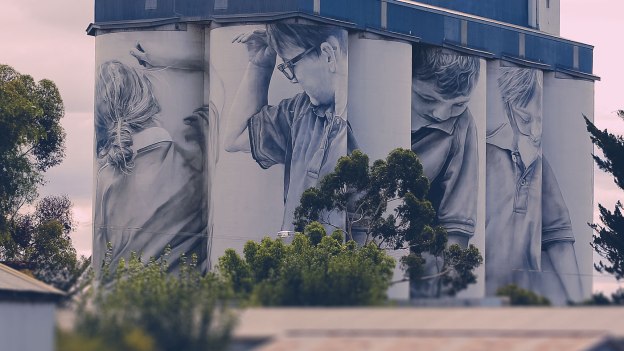It sends a shiver down my spine. I see strange elongated figures dancing, wearing tall headdresses, limbs swaying to the beat. They share a space with crosshatched echidnas, giant kangaroos and striped thylacines. I almost hear the voices from the past, ancient humans communicating across tens of thousands of years. The rock art in the Kimberley region is unforgettable.
On our way back from Mitchell Falls, we find two aboriginal art sites. The land here is flat and sandy, dotted occasionally with stacks of quartzite boulders. The cultural sites at Munurru are well marked and easy to find from the road. The well beaten path from the car park leads the way, but then you are on your own. There are no signs telling you where to look, or even what to look for. We become explorers, searching the jumbled pile of flat rocks and rounded boulders for the best place to paint. We look for a hidden recess, the underside of a rocky overhang, the roof of a small cave – a flat piece of rock, easy to reach, well protected from the elements. We try to think as the artists did, to adjust our eyes to look for a red, white or yellow line that is man made. And suddenly the art begins to reveal itself.

Echidna rock art
The paintings are drawn in red ochre, yellow, black and white. Many are overpainted. Some are clearly recognisable human figures, animals and plants. Kangaroos are easy to recognise. There are root vegetables, maybe yams? A striped animal with a straight tail has to be a thylacine, the Tasmanian Tiger, painted thousands of years ago when he still lived this far north on the mainland. He’s sadly now extinct. Two huge birds painted lying horizontally, head to head, look like brolgas. Thankfully these elegant birds are still with us.
Human figures wear what appear to be grass skirts and pointed head dresses with tassels. They are shown moving, with bent knees and elbows, I assume in a dance. They are beautifully painted in a very distinctive style. Apparently they are examples of the famous Gwions or Bradshaw figures that are found throughout the Kimberley region. People are also painted more simply, carrying bags or boomerangs and wearing skirts. Pictures of daily life.
Leaving the obviously human figures, we move on to panels of otherworldly creatures. Odd squatting frog like figures appear in one shelter. I learn later they are child spirits, the first sign of new human life. When a woman is found to be pregnant it is believed her husband has dreamed of a child spirit and allowed it to enter his wife.

Wandjina rock art at Munurru
It is said the child spirits came originally from the Wandjina, the mythical ancestors who sang the land into being. The Wandjina panels at Munurru are eerie. The ancestors have stark white alien faces with large blank eyes that stare impassively back at the observer. They guard a burial site where a human skull and bones have been placed on a rock ledge in the sacred site. A common practice in this tradition.
A cooling wind blows gently through the boulders, but the air is heavy here with human history, with stories of the oldest surviving human culture on the planet, with images representing powerful myths that have endured for millennia.
Research continues, but recent dating of artefacts in the Kakadu indicates that aboriginal people have lived on this continent for 50-60 thousand years. Imagine that. It’s humbling.
Kimberley foundation: Kimberley Foundation on YouTube







